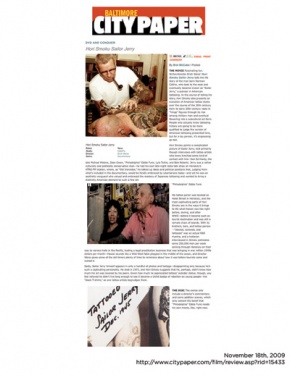News
Hori Smoku in The Baltimore City Paper
11/19/09
The Baltimore City Paper

DVD and Conquer
Hori Smoku Sailor Jerry
By Bret McCabe | Posted
THE MOVIE Fascinating fun. Writer/director Erich Weiss’ Hori Smoku Sailor Jerry tells the life story of the man born Norman Collins, who took to the seas and eventually became known as “Sailor Jerry,” a pioneer in American tattooing. In the course of telling his story, Hori Smoku also presents an evolution of American tattoo styles over the course of the 20th century, from its early 20th-century roots in “fringe” figures through its rise among military men and eventual flowering into a subcultural art form. People who actually know tattooing history are going to be more qualified to judge the version of American tattooing presented here, but for a lay person, it’s engrossing as hell.
Hori Smoku paints a complicated picture of Sailor Jerry, told primarily though interviews with tattoo artists who knew him/had some kind of contact with him: Don Ed Hardy, the late Michael Malone, Zeke Owen, “Philadelphia” Eddie Funk, Lyle Tuttle, and Bob Roberts. Jerry was a rather culturally and politically conservative man—he had his own late-night radio talk show on Honolulu’s KTRG-FM station, where, as “Old Ironsides,” he talked up ideas and political positions that, judging from what’s included in the documentary, would be fondly embraced by Libertarians today—and yet he was an aesthetic vanguard who valued and embraced the mastery of Japanese tattooing and wanted to bring a distinctly American element to such a fine art.
"Philadelphia" Eddie Funk
His tattoo parlor was located on Hotel Street in Honolulu, and the most captivating parts of Hori Smoku are in the ways it brings to life what Hawaii was like right before, during, and after WWII—before it became such as tourist destination and was still a remote chain of islands. With its brothels, bars, and tattoo parlors—"stewed, screwed, and tattooed" was an actual R&R mantra, and a historian interviewed in Smoku estimates some 250,000 men per week coming through Honolulu on their way to various hells in the Pacific, fueling a legal prostitution business that was bringing in one million 1940s dollars per month—Hawaii sounds like a Wild West fable plopped in the middle of the ocean, and director Weiss gives some of the old timers plenty of time to reminisce about how it was before tourists came and ruined it.
Sadly, Sailor Jerry himself appears in only a handful of photos and footage—disappointing only because he’s such a captivating personality. He died in 1973, and Hori Smoku suggests that he, perhaps, didn’t know how much his art was revered by his peers. Given how much he appreciated tattoos’ outsider status, though, you feel relieved he didn’t live long enough to see it become a cliché badge of rebellion on young people—the “black T-shirts,” as one tattoo artists begrudges them.
THE DISC The extras only include a director’s commentary and some addition scenes, which only cement the belief that “Philadelphia” Eddie Funk needs his own movie, like, right now.
